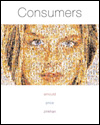We have briefly overviewed the question of how and why we learn about consumers
in this chapter. Consumer behavior research is concerned with systematically
collecting and analyzing information in order to improve the quality of exchanges
between organizations and their customers or constituents. That is, organizations
create value by improving the quality of exchanges. Consumer behavior research
is undergoing dramatic change because of speed, globalization, the Internet
and data overload. The consumer researcher of this century will need to work
smarter, faster and have more diverse skills than ever before. We distinguish
between basic and applied research, and explain exploratory, descriptive, and
causal research. There are five main steps in the research process. We give
examples of the steps we go through in conducting consumer research and point
out some of the key areas of concern in interpreting and using market intelligence.
We stress that the research process is iterative, different methods and perspectives
lead to different research results, and no consumer research is perfect. Because
collecting verbal and written information from consumers is so central to the
research process and because it throws many important issues in the research
process into relief, we devote considerable attention to the problem of asking
questions effectively. We mention three main considerations in developing questions
and introduce the BRONS guidelines for effective question development. Conducting
international consumer research is even more complicated than conducting consumer
research in a single, national context, so we also explore some of the problems
encountered in cross-cultural consumer research. Here, we review special problems
associated with conceptual equivalence, and sources of response bias. The Internet
is likely to have a dramatic impact on how consumer research is done over the
next five years. We also provide a discussion of how this technology is changing
consumer research in this chapter. Collecting and analyzing information about
consumer behavior raises a host of ethical questions. We briefly review some
of these issues and provide guidelines for conducting ethical research. Finally,
we invite you to enter the exciting world of consumer research and point out
that most of what you read in this textbook is a result of consumer behavior
research. |




 2002 McGraw-Hill Higher Education
2002 McGraw-Hill Higher Education


 2002 McGraw-Hill Higher Education
2002 McGraw-Hill Higher Education